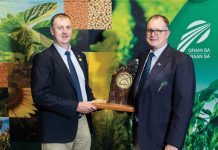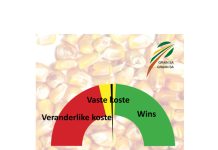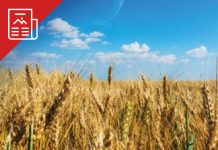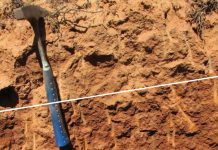This article is the seventh in a series of articles highlighting a specific pasture crop species that can play an imperative role in conservation agriculture (CA) based crop-pasture rotations. Besides improving the physical, chemical, hydrological and biological properties of the soil, such species, including annual or perennial cover crops, can successfully be used as animal feed.
Livestock production systems are in many ways dependant on the utilisation of pasture species, in this case as a pasture ley crop, and can therefore become an integral component of CA-based crop-pasture rotations. It is imperative however to identify a pasture species fulfilling the requirements of a dual purpose crop, i.e. for livestock fodder and soil restoration.
Anthephora pubescens/bottle brush grass (borseltjiegras)
Bottle brush grass is a perennial, tufted grass with a single ear inflorescence that grows on long, thin tillers.
The length of the tillers can vary from anything between 400 mm – 1 200 mm. The leaves have a typical blue-green colour and vary between hairy to hairless. Different ecotypes of the grass have been evaluated in the past at the Vaalharts Research Station, however to date, the two most common cultivars on the market are Common and Wollie.

Agro-ecological distribution
Bottle brush grass is found widely in South Africa and is adapted to various growing conditions. It grows mostly on sandy soils and is often grown on high clay content soils. The best production has been achieved on soils with a relatively neutral pH of 6,5.
One of the most attractive characteristics of the grass is that it can grow in soils with a relatively low phosphorus (P) status. Bottle brush grass is naturally found in warm and arid areas. It grows in regions with an annual rainfall of between 250 mm – 650 mm.
Management and utilisation
Bottle brush grass should be established on a weed free and fine compacted seedbed. If this species is to be planted on acidic soil, the soil’s pH needs to be increased to 6,5 by using agricultural lime.
Soils with a low P content will require approximately 150 kg/ha – 200 kg/ha of superphosphate before the establishment of the species. Bottle brush grass is however adapted to soils with a low P content; this recommendation is to ensure a higher production.
The best time for seeding bottle brush grass is at the end of January till the end of February. However, if weeds do not pose any threat to establishment, earlier planting is a viable option. In this context it can be said that this grasses’ seedlings are very competitive with weed species compared to the seedlings of grasses such as Cenchrus ciliaris, Digitaria eriantha and Panicum maximum.
In general it is recommended that the best time for establishment is the time of the year when the rainfall is most reliable.
It is advisable that freshly harvested seed should rather not be planted, but that the seed is allowed to ripen/mature for at least nine to twelve months before planting. This species can be planted at rates of 3 kg/ha – 5 kg/ha in 1,5 m – 0,75 m rows and up to 7 kg/ha for broadcast seeding.
Good stands of bottle brush grass have been achieved in the Molopo region at seeding rates of 2,5 kg/ha to 14 kg/ha. For optimal stand densities, good quality seed at 5 kg/ha for row plantings and 7 kg/ha to 9 kg/ha for broadcast seeding is recommended. Row plantings are preferred in drier regions to make better use of soil moisture.
As previously mentioned, bottle brush grass has the ability to survive on soils with low levels of P, but it is however recommended to maintain a soil P content of nothing lower than 12 mg P/kg of soil for high production.
Nitrogen (N) applications will mainly be determined by rainfall received. During the dry season, N applications should be in the order of 20 kg N/ha to be economical. If the rainfall is higher than 450 mm per year, an application rate of 75 kg/ha can be used together with 25 kg P/ha and 50 kg K/ha.
Research in the Free State has shown that it is not only the macronutrients that are important in this pasture species production, but also the micro-nutrients. This research indicated that the zinc content can be lower than the grazing animal requires. This situation, like many other cases with micro-nutrient deficiencies, can be ascribed to micro-nutrient poor soil. It is therefore imperative that such soils which indicate micro-nutrient deficiencies, are amended to improve the quality of the pasture where needed.
Since bottle brush grass is known to be a palatable grass under harsh growing conditions, it can be used confidently as both a summer and winter grazing (foggage). Bottle brush grass has proven its value in the North West province as an excellent foggage species. One of the most important contributing factors to this was leaf abundance and quality.

Management challenges
As previously mentioned, bottle brush grass has very woolly seeds and the establishment of this seed can therefore be difficult on a windy day.
Wind erosion and waterlogged conditions can create problems for successful establishment. Seed coating technologies can facilitate this process to ensure better establishment of the seed. There have been reports that bottle brush grass should not be irrigated, since this led to rust which affected the health of the plant and resulted in its degeneration. This grass is also not recommended for hay production.

Soil conservation and health benefits
Bottle brush grass has shown its tolerance to dry conditions, this is normally strongly correlated to very poor quality soils.
Quite often the soils which are planted to bottle brush grass are sandier soils that are susceptible to wind erosion. This species however, has the potential to grow in theses sandy and often nutrient poor soils and binds these soils to protect them against eroding.
As a result of this species’ excellent water and nutrient use efficiency, the amount of nutrients and water used for growth from the soil is replaced by an insurmountable soil organic matter that is deficient before. Indirectly this creates better soils structure, improves water holding capacity and provides an energy source for soil microorganisms which are subsequently responsible for better nutrient availability and assimilation.

Animal production aspects
With regards to bottle brush grasses’ production and quality, it has been noted that it can be expected to carry one large stock unit (LSU) per 5 ha – 6 ha under dryland conditions in the drier bushveld regions with a rainfall of approximately 400 mm.
In higher rainfall conditions of approximately 600 mm per growing season, it is possible to carry one LSU per 2 ha – 3 ha. Actual grazing capacity numbers obtained in the Vaalwater region, have indicated that one LSU/ha for 80 days in the summer is achievable, and as a result, up to 112 kg/ha of beef can be produced according to Dickinson et al., (1990).
This amounts to 0,4 LSU/ha/180 days or 2,5 ha/LSU/180 days. In the western regions of the Northern Cape Province, Fourie et al., (1984) obtained 100 LSU grazing days per hectare on mature bottle brush grass. This results in a grazing capacity of 0,5 LSU/ha/180 days or 3 ha/LSU/180 days.
It is commonly known that bottle brush grass has a lower dry matter (DM) production than the other well-known drought tolerant blue buffalo grass.
A general rule of thumb used to estimate dry matter production, is 0,75 ton/ha per 100 mm rain received. As a result of a higher utilisation percentage (± 90%), this will compensate for the lower DM production obtained, since livestock production is generally much better than with this grass.
Research in the Free State has shown that the crude protein content of bottle brush grass can vary between 6% and 10% in the summer, and in winter it can go below 6%. The digestibility has also been measured to be approximately 55% in the growing season and even as low as 50% in winter in the summer.
Conclusion
The drought tolerant sub-tropical bottle brush grass has been a reliable pasture for many decades. In areas where soils are nutrient poor and the rainfall is low, this species has the ability to provide good quality pasture for optimal livestock production.
Where soils have become depleted through intensive tillage in an area where a relatively acceptable rainfall is received, this species will flourish and provide an opportunity to improve the soil’s physical condition and to some extent its nutritional status, while providing good quality grazing through more of the growing season right up to the middle of winter.
For more information, contact Dr Wayne Truter at wayne.truter@up.ac.za, Prof Chris Dannhauser at admin@GrassSA.co.za, Dr Hendrik Smith at hendrik.smith@grainsa.co.za or Mr Gerrie Trytsman at gtrytsman@arc.agric.za.

















